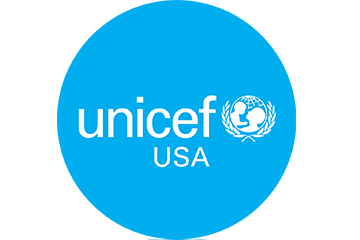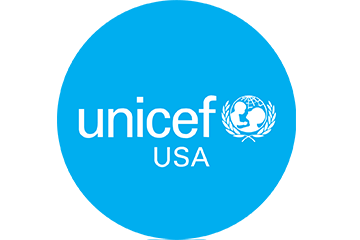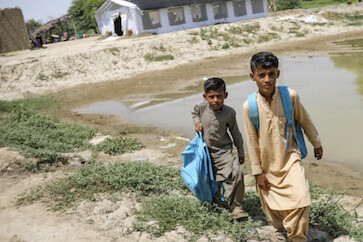For some, getting vaccinated for COVID-19 means getting to see and hug a grandchild again after a long time apart. For others, a dose offers an opportunity to get back to earning a living and supporting a family.
When UNICEF helped launch the largest vaccine operation effort in history, the focus was to make sure that every community was protected from COVID-19. And since the COVAX initiative began in February 2021, more than 1.4 billion doses have reached more than 140 countries.
Here’s a look at some successful vaccination efforts in various countries where UNICEF works.
In Bangladesh, community volunteers mobilize others to get vaccinated
When the first doses supplied by COVAX touched down in Dhaka in June 2021, less than 4 percent of all adults were fully vaccinated against COVID-19. Fast forward less than a year and that number had jumped to 67 percent by early April 2022.
COVAX has played a crucial role in that achievement; more than half of all the COVID-19 vaccines delivered to Bangladesh last year were through the program.
Young volunteers in Bangladesh have played an important role in making sure the shots went into people’s arms. They’ve been reaching out to communities to amplify the message that COVID-19 vaccines are safe and available.
Mukta, a 25-year-old studying nutrition and lifelong resident of Dhaka, says her desire to help other people during the pandemic prompted her to join UNICEF as a volunteer. She has been going door to door, often talking to elderly people, families living in slums, and those who don’t have access to a mobile phone or the internet.
“I’ve seen so many vulnerable people,” Mukta says. “I enjoy going to people’s homes and raising awareness about vaccination. I love helping them.”
Nazma, 50, is one person Mukta helped to register online to get the COVID-19 vaccine. For Nazma, getting vaccinated came as a massive relief. “I didn’t have access to a smartphone. I didn’t know how to register for vaccination. I didn’t even know where to get help,” Nazma says. “I was afraid I might not get vaccinated.” She’s now vaccinated.
In Peru, vaccinated grandparents reunite with their grandchildren
Peru’s COVID-19 vaccination drive has meant that older, more vulnerable adults have been able to see and hug their families again.
For Artemio Baldoceda, getting vaccinated means “joy in my heart. I’m getting a little more life to have my family, and for my family to have me.
“You miss the grandchildren, especially. One waits for that moment to come when you can bear hug them.”
For Carmen Castañeda, a nurse at the Los Libertadores health center in Lima supporting vaccination efforts, the work is personal.
“I feel as if every person I vaccinate could be my mum or dad,” Castañeda says. “The elderly people feel very happy, delighted.”
COVAX played a significant role at the beginning of the vaccine drive in Peru in 2021, and has since supplied more than 8.2 million COVID-19 vaccines to the country. In just seven months, the proportion of adults who have received two doses in Peru surged from 25 percent to almost 80 percent.
In Vietnam, vaccinations offer an economic lifeline
There’s been a rapid rise in the COVID-19 vaccination rate in Vietnam as well over the past few months. In September 2021, less than 10 percent of all adults in the country had received both doses; by April 2022, more than 78 percent of those over age 12 had been given two shots.
UNICEF has been working with Vietnam’s government to provide COVID-19 vaccines for about 35 percent of the country’s population through COVAX. Those doses have been crucial for not only protecting people’s health, but also protecting their livelihoods.
Take Lo Thi Son, for example, who lives in a remote village in the northwest mountains with her two young daughters. During the pandemic, both Son’s husband and her father-in-law lost their jobs. Son hoped to supplement the family income by selling vegetables at a local market, but the health risks made that hard.
“I felt sad because I did not have enough money to buy diapers or milk,” Son recalls. “I was also scared of going to crowded places as a young mother with little children.”
The opportunity to get the COVID-19 vaccine was an economic lifeline. “[The] COVID-19 vaccine makes me feel more confident and assured,” Son said ahead of getting her second dose last November. “I will be able to go to the market and safely sell vegetables to earn more income for my family.”
In the Philippines, help with equipment and logistics boosts coverage in remote areas
COVID-19 vaccination rate has risen significantly in the Philippines with support through the COVAX initiative. By April 2022, 59 percent of the population had been fully vaccinated up from 18 percent last September. About one in three of all the COVID-19 vaccines administered had come from COVAX.
Making sure communities have access to the doses in the country presents specific challenges. It requires reaching hundreds of hard-to-reach islands and often disaster-prone regions. Take Kabugao, for example, a municipality nestled in the mountains a few hundred miles north of Manila.
Extreme flooding and landslides are common in the area, and the power sometimes goes out. That creates a major challenge, as the COVID-19 vaccines need to be stored at low temperatures in refrigerators and freezers. So, with support from partners, UNICEF has supplied dozens of solar-powered refrigerators to Kabugao and other communities like it to make sure the doses can last even when electricity is lost.
Given the state of today’s market, there are now enough COVID-19 vaccine doses to meet the needs of low- and middle-income countries. This means UNICEF and partners can focus less on resolving supply constraints and more on making sure that vaccines are turned into vaccinations. It means supporting countries with weaker health systems to ensure that there are enough trained health care workers, that the necessary logistics in place and there is sufficient access to equipment like syringes and cold-storage freezers.
Learn more about what a strong health system looks like and why that’s vital in the fight against COVID-19.
Learn more about UNICEF’s role in COVAX, leading efforts to procure and supply COVID-19 vaccines.
Support UNICEF’s global immunization efforts. Donate today.
Top photo: Mukta, 25, left, a UNICEF volunteer, celebrates with another member of her community, Belaton, 53, whom she helped get vaccinated for COVID-19. Mukta is one of 3,900 volunteers who have been helping UNICEF Bangladesh implement COVID-19 vaccinations in the country, effectively boosting the country’s vaccination rate from a low 4 percent in June 2021 to 67 percent in April 2022. Mukta goes door-to-door in communities providing information and helping people like Belaton get registered and get vaccinated. The two women are flashing the V for vaccinated sign at the Shimantik Clinic in Khilgaon, Dhaka, on Oct. 10, 2021, after Belaton received her second dose. © UNICEF/UN0537623/Kiron





